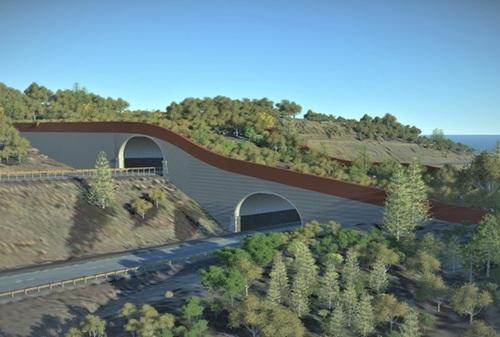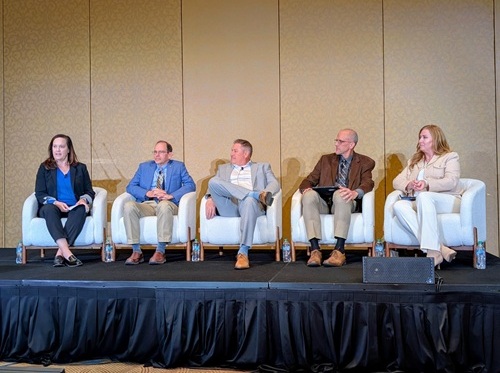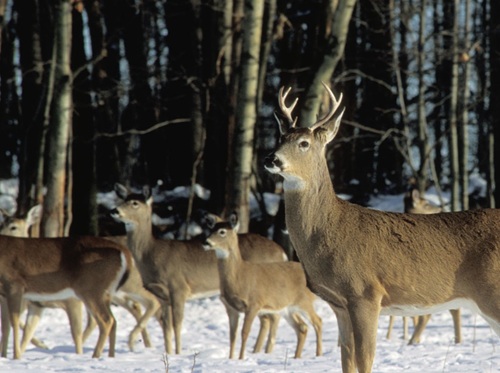The Federal Highway Administration recently awarded $125 million in grants to 16 wildlife crossing projects in 16 states, including one Native American Tribe.
[Above photo via the Michigan DOT]
The agency said that this is the second round of grants issued via its Wildlife Crossings Pilot Program, a program created in the Infrastructure Investment and Jobs Act or IIJA of 2021. The FHWA issued $110 million in grants to 19 wildlife crossing projects in 17 states via the first round of disbursements of this program in December 2023, which included four projects overseen by Native American tribes.

Overall, the IIJA makes a total of $350 million available over five years through fiscal year 2026 via the Wildlife Crossings Pilot Program.
In a statement, the agency said the purpose of the Wildlife Crossings Pilot Program is to help reduce vehicle collisions with wildlife while also improving habitat connectivity and support the survival of threatened or endangered species. Subsequently, program funding supports studies and projects that construct wildlife crossings over and below busy roads, add fencing to direct animals to the crossings, and monitor performance of crossing systems, FHWA said.
The agency added that, each year, more than one million wildlife vehicle collisions occur nationwide that result in approximately 200 human fatalities and 26,000 injuries to drivers and their passengers.
Those collisions also cost the public more than $10 billion annually, FHWA added; a figure that includes economic costs, such as loss of income, medical costs, property damage, and more. Highways can threaten wildlife populations by fragmenting habitats, creating barriers to safe movement, and causing wildlife vehicle collisions.
Several state departments of transportation received grants via this round of disbursements from the Wildlife Crossings Pilot Program. They are:
- $626,659 to the Alaska Department of Transportation and Public Facilities to conduct a study that will develop a comprehensive solution to preventing vehicle collisions with moose along Glenn Highway; the state’s busiest highway.
- $565,800 to the Arizona Department of Transportation to develop an online Geographic Information System or GIS mapping tool that will help identify wildlife-vehicle collision hotspots, analyze data about collisions, identify wildlife corridors for habitat connectivity, develop and prioritize projects, and build cost estimates to support future wildlife mitigation projects.
- $6.1 million to the Florida Department of Transportation for a wildlife crossing and fencing along US-27 in southern Highlands County near the community of Venus.
- $2.2 million to the Georgia Department of Transportation to develop an institutional framework that will integrate wildlife-vehicle reduction measures and habitat connectivity goals into transportation project planning and construction.
- $21 million to the Idaho Department of Transportation for three wildlife underpasses with eight-foot-tall fencing along six miles of US-30 at Rocky Point in rural Bear Lake County.
- $9.3 million to the Maine Department of Transportation for a wildlife crossing using a pre-cast concrete arch culvert to provide passage for moose, deer, and other large wildlife in the city of Caribou.
- $387,424 to the Maryland State Highway Administration – a division of the Maryland Department of Transportation – to develop a comprehensive plan designed to reduce wildlife-vehicle collisions statewide.
- $1.7 million to the Massachusetts Department of Transportation to fund pre-construction design and permitting for a wildlife crossing project along the Appalachian Trail over Interstate 90 through western Massachusetts.
- $467,376 to the Michigan Department of Transportation to collect ecological and transportation data needed to identify roadways that present the greatest risk to motorists and wildlife.
- $900,000 to the Missouri Department of Transportation to design and construct multiple wildlife vehicle mitigation projects along Interstate 70 and Interstate 64.
- $424,242 to the Montana Department of Transportation to study and develop plans that reduce wildlife vehicle collisions along 30 miles of US-93 from the Idaho border to Darby, MT.
- $16.8 million to the Nevada Department of Transportation to build 61 wildlife crossings along US-93 and install 68 miles of barrier fencing aimed at reducing wildlife-vehicle collisions while connecting critical habitat for the federally- threatened Mojave Desert tortoise.
- $323,850 to the New York State Department of Transportation to conduct a two-phase study about wildlife-vehicle collisions and ways to improve habitat connectivity.
- $25 million to the North Carolina Department of Transportation for multiple wildlife underpass structures and fencing along US-64 in the Alligator River National Wildlife Refuge in Dare County.
$33.2 million to the Oregon Department of Transportation to build a wildlife crossing along Interstate 5 within the Cascade-Siskiyou National Monument area. The project includes construction of a wildlife overpass bridge and fencing to direct wildlife to the structure within the Mariposa Preserve.
 Nation
Nation
Building More Resilient Transportation Systems
November 21, 2025 Nation
Nation

